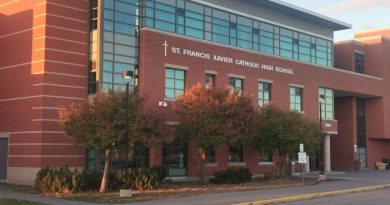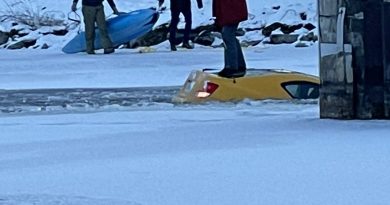Residents on Zoom meeting raise concerns over coyote sightings
By Charlie Senack
As coyote sightings in suburban and rural village areas continue to grow, the councillor for Gloucester-South Nepean held an information session to inform local residents.
The virtual zoom meeting held by Councillor Carol Anne Meehan on Thursday, March 18, was joined by more than 50 residents — primarily from the Riverside South and Barrhaven communities.
Wildlife experts who were part of the call said coyotes are prone to urban and suburban communities thanks to their habitat. They are not forest animals like many think and are attracted to small animals like rabbits, mice, moles and rats, which are all common in our neighborhoods. The amount of food and garbage left out by humans has also made our suburban streets a desire and is fueling their diets.
“There are some people who will feed coyotes — it’s very strange but they do,” said Nick Stow, Ecologist and Environmental Planner for the City of Ottawa. “It also comes from people putting food outside for their dogs (or) not properly putting out their garbage.”
The animals have a sweet tooth and our leftovers they are now eating are making the animals more sick which poses a risk to us all.
According to research done at the University of Alberta, Coyotes that eat food discarded by humans tend to be unhealthy and may pose a health risk to humans since they carry more parasites and have gut bacteria linked to aggression.
With more people at home due to the COVID-19 pandemic, the amount of waste we throw out has also been increasing leading to more garbage being put out on the curb.
Stow says it is always a good idea whenever possible to wait until the day of collection instead of the night before to make sure the coyotes don’t stop by for a midnight snack.
Some people are also leaving food out for other animals which are causing the coyotes to move closer to our homes and backyards. Others are just leaving out food for their own pets but are also attracting many other animals. Some fruit trees can also lure the coyotes in.
“Coyotes love fruit; their diet consists of a lot of fruit in the winter in particular,” Stow said. “So if you have an apple tree or a cherry tree that you don’t clean up in the fall, coyotes will go there.”
Coyote sightings have been on the rise in recent years; no more so than in the first few months of 2021.
According to data released during the virtual meeting, Ottawa’s 311 phone line has received 41 reports of coyote sightings in Gloucester-South Nepean in just the first two and a half months of this year. That’s compared to six total reports in all of 2019 and zero in 2020.
Many of those numbers are from the same households and often have to do with the same few coyotes, said city officials, but still the numbers show coyote sightings are rising.
During the question and answer part of the meeting, many residents expressed concerns about the large number of coyotes being spotted in the Barrhaven and Riverside South communities. What’s concerning to them is how comfortable the animals are becoming with humans.
But Stow said what many might see as a threat is really a coyote engaging in typical behaviour. He stressed that having coyotes live among us is completely safe, calling it a “risk”.
You’re encouraged to call 311 and report coyote sightings whenever you see them in an environment which isn’t typical for the animals. If you see a coyote roaming in an open empty field it’s no cause for concern and shouldn’t be reported.
“You may see coyotes stand and look at you; that is not an aggressive animal,” said Stow. “Aggressive animals are when they show persistent patterns of attacking animals on a leash or going after people in broad daylight. If it’s needed that animal will be trapped and killed. It’s a very rare instance.”
From 1970 to 2014, only 367 coyote attacks have been reported in the United States and Canada, said Stow, who adds other risks like lightning strikes have much higher rates of Injury in this country .
“The risk of injury from a coyote is about 10 times less than a lightning strike and about 500 times less of a risk than an attack from a dog,” he said. “Yes coyotes are a hazard but the risk is very small.”
Even if coyotes become comfortable with humans, that doesn’t mean they provide more of a threat; Instead it means they will be more visible. Problems only arise when they begin to show aggressive behaviour such as with a recent incident in Riverside South in June 2020.
That’s when a large coyote was seen roaming Beryl Gaffney Park and surrounding streets showing no fear to humans. The large dog-like animal bit a number of people including an 83-year-old woman and chased multiple others — many of the attacks taking place in broad daylight.
Some speculated the coyote was sick given its odd behaviour, but after it was trapped and killed due to being a safety risk to the public, testing on its body revealed it was in perfect health. It’s behaviour was rare and uncommon.
Incidents like this have put many residents on edge but Stow says in the last decade, he can only recall three times coyotes have had to be trapped and killed — an action which is always a last resort. Besides the incident in Riverside South, the other two incidents had to do with coyotes who were infected with mange, which is transmitted by a mite that infects an animal by burrowing into their skin.
Some residents asked why more efforts aren’t being taken to limit the coyote population by killing or moving the animals when they are seen roaming urban areas.
“We can’t manage the intensity enough to have an impact. Every coyote habitat in Ottawa has a coyote living in it,” responded Stow. “Removing a coyote from a neighborhood if it is not a public risk just won’t work because you will have (new) coyotes back almost immediately.”
When coyotes begin to realize that a coyote isn’t coming back, a pack will often break apart and move into vacated dens. Each community in Ottawa has coyotes living within them and Stow predicts many people have unknowingly been within a few hundred feet of the animals who are hiding and watching in the shadows. Coyotes are more commonly spotted in the winter when there are no leaves on the trees and the brush is more bare.
Urban coyotes only live an average of 18 to 24 months which means if a community reports a problem one year, it’s very likely it will resolve itself by the next year.






